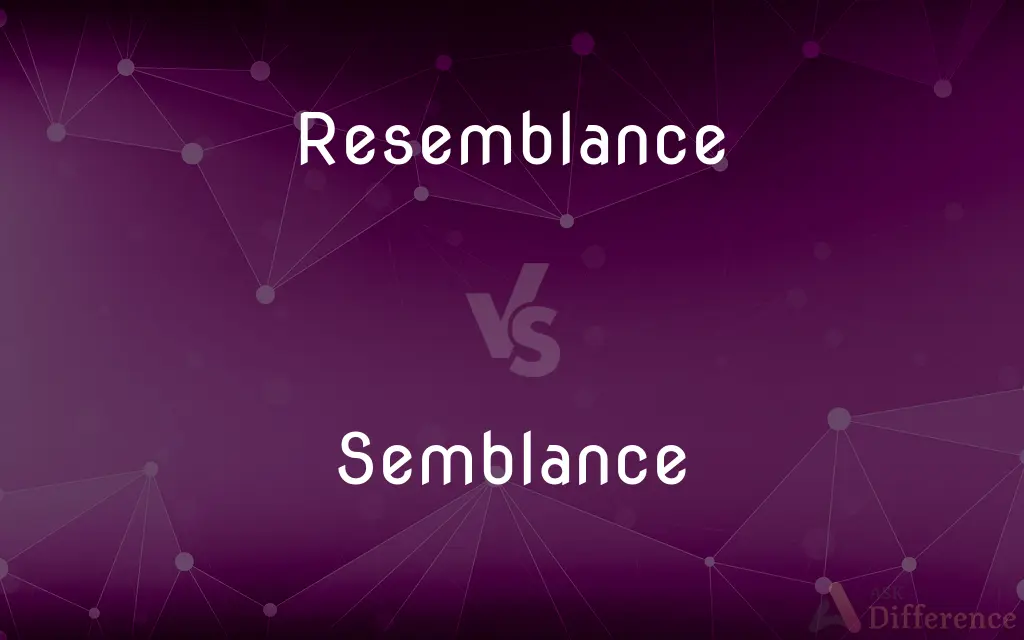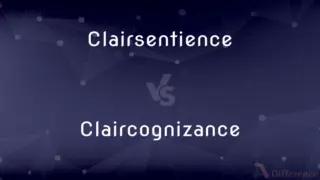Resemblance vs. Semblance — What's the Difference?
By Maham Liaqat & Urooj Arif — Updated on March 28, 2024
Resemblance refers to the similarity or likeness between two things, emphasizing actual shared characteristics, while semblance is about the outward appearance or impression of something, often regardless of the underlying reality.

Difference Between Resemblance and Semblance
Table of Contents
ADVERTISEMENT
Key Differences
Resemblance highlights the comparison between two or more entities, focusing on their common attributes, qualities, or appearances that make them alike. It implies a deeper level of similarity that can be based on physical characteristics, behaviors, or even abstract qualities, suggesting a genuine likeness. On the other hand, semblance pertains to the surface-level appearance or the facade that something presents, which may not necessarily reflect its true nature or essence.
In literary contexts, resemblance is used to draw parallels between characters, settings, or themes, highlighting connections or similarities that contribute to the narrative's depth. Semblance, however, is frequently employed to explore themes of illusion versus reality, where characters or situations appear in a certain way that masks the true state of affairs. This distinction points to semblance's association with deceptive appearances or a facade maintained for specific purposes.
When discussing relationships or comparisons, resemblance implies a natural or inherent similarity that prompts a comparison. It's often used in a more objective sense, where the similarities can be quantified or clearly identified. Semblance, in contrast, carries a more subjective or interpretative quality, suggesting that the appearance of similarity or conformity might be intentional or artificial, designed to fulfill a particular perception or expectation.
In the context of personal identity or authenticity, resemblance can affirm connections and shared identities, such as cultural, familial, or historical links. It reinforces the idea of genuine similarity or heritage. Meanwhile, semblance might be involved in contexts requiring conformity or when an individual or group adopts certain appearances or behaviors to fit in or meet specific criteria, potentially at the cost of concealing their true characteristics or beliefs.
The choice between using resemblance or semblance often hinges on the speaker's intent to convey either a genuine likeness or an outward appearance that may not fully capture the underlying reality. While resemblance invites an exploration of true similarities, semblance challenges observers to question the veracity of the appearances before them.
ADVERTISEMENT
Comparison Chart
Definition
Similarity or likeness in qualities, appearance, or nature.
Outward appearance or impression, possibly deceptive.
Implication
Genuine similarity or shared characteristics.
Surface-level appearance, possibly without underlying similarity.
Usage Contexts
Drawing parallels, identifying shared traits.
Describing facades, illusions, or superficial conformity.
Objective/Subjective
More objective, based on identifiable similarities.
More subjective, related to perceptions of appearance.
Depth
Indicates a deeper level of likeness.
Suggests a superficial or cosmetic level of appearance.
Literary Application
Used to highlight true connections or similarities.
Used to explore themes of illusion vs. reality.
Relation to Reality
Reflects actual similarities.
May not reflect the true nature or essence.
Compare with Definitions
Resemblance
Likeness or similarity in appearance or characteristics.
There's a strong resemblance between the two paintings in style and theme.
Semblance
Often associated with facades or superficial qualities.
The movie villain only had a semblance of loyalty to the cause.
Resemblance
Used to compare and contrast entities based on shared attributes.
The resemblance between the novel's protagonist and the author's own life is striking.
Semblance
Used to describe efforts to appear in a certain way.
He adopted a semblance of indifference, though he was deeply affected.
Resemblance
Can denote similarities in behavior or mannerisms.
The child's resemblance to her parents extends beyond looks to her cheerful disposition.
Semblance
Can imply a deliberate presentation or disguise.
The semblance of calmness was crucial for the negotiation's success.
Resemblance
Reflects genuine shared traits or qualities.
Their physical resemblance is uncanny, indicating a possible family connection.
Semblance
An outward appearance or impression, which may be misleading.
Despite the chaos, she maintained a semblance of order.
Resemblance
Often observed in nature, objects, or concepts.
The resemblance of the leaf's shape to a heart is notable.
Semblance
Relates to the concept of seeming rather than being.
The semblance of happiness in the photos hid their true feelings.
Resemblance
The state or quality of resembling, especially similarity in appearance or in external or superficial details.
Semblance
An outward or token appearance
"Foolish men mistake transitory semblance for eternal fact" (Thomas Carlyle).
Resemblance
Something that resembles another; a likeness or semblance.
Semblance
A representation; a copy.
Resemblance
The quality or state of resembling.
Semblance
The barest trace; a modicum
Not a semblance of truth to the story.
Resemblance
That which resembles, or is similar; a representation; a likeness.
Semblance
Likeness, similarity; the quality of being similar.
Resemblance
A comparison; a simile.
Semblance
The way something looks; appearance; form
Resemblance
Probability; verisimilitude.
Semblance
Seeming; appearance; show; figure; form.
Thier semblance kind, and mild their gestures were.
Resemblance
The quality or state of resembling; likeness; similitude; similarity.
One main end of poetry and painting is to please; they bear a great resemblance to each other.
Semblance
Likeness; resemblance, actual or apparent; similitude; as, the semblance of worth; semblance of virtue.
Only semblances or imitations of shells.
Resemblance
That which resembles, or is similar; a representation; a likeness.
These sensible things, which religion hath allowed, are resemblances formed according to things spiritual.
Semblance
An outward or token appearance or form that is deliberately misleading;
He hoped his claims would have a semblance of authenticity
He tried to give his falsehood the gloss of moral sanction
The situation soon took on a different color
Resemblance
A comparison; a simile.
Semblance
An erroneous mental representation
Resemblance
Probability; verisimilitude.
Semblance
Picture consisting of a graphic image of a person or thing
Resemblance
Similarity in appearance or external or superficial details
Common Curiosities
Can something have both resemblance and semblance?
Yes, an entity can exhibit both resemblance and semblance, showing genuine similarities in some aspects while presenting an outward appearance that might be misleading in others.
How do resemblance and semblance differ in their depth of meaning?
Resemblance suggests a deeper level of likeness or shared characteristics, while semblance tends to indicate a more superficial or cosmetic appearance.
How do authors use resemblance and semblance in literature?
Authors use resemblance to draw connections and highlight true similarities, while semblance is often employed to explore themes of illusion versus reality, challenging readers to discern the truth beyond appearances.
Can semblance be trusted to reveal the true nature of something?
Semblance often refers to an outward appearance that may not accurately reflect the true nature or essence of something, implying that it can be deceptive or superficial.
What role does perception play in semblance?
Perception plays a crucial role in semblance, as it involves the observer's interpretation of an outward appearance, which may or may not align with the actual reality.
Can the concept of semblance apply to personal identity?
Yes, semblance can apply to personal identity when individuals or groups present themselves in ways that conform to certain expectations or norms, potentially masking their true selves or beliefs.
How does resemblance contribute to the study of art history?
In art history, resemblance plays a crucial role in tracing influences, styles, and connections between different artists, periods, and movements, highlighting how certain themes or techniques are shared or evolved.
What does resemblance indicate in a comparison?
Resemblance indicates a genuine similarity or likeness in characteristics, appearance, or nature between entities, suggesting a deeper connection or shared attributes.
Is semblance always negative or deceptive?
While semblance can imply deception or superficiality, it's not always negative; it can also describe efforts to maintain dignity, order, or positivity in challenging situations.
How do resemblance and semblance differ in their application to personal relationships?
In personal relationships, resemblance might refer to shared interests, traits, or backgrounds that deepen connections, while semblance might relate to the outward display of harmony or compatibility that may not accurately reflect the relationship's true dynamics.
Does a strong resemblance imply a genetic relationship?
A strong resemblance can suggest a genetic relationship, especially in the context of physical traits shared among family members, but it is not conclusive without genetic testing.
Is semblance always intentional?
Semblance is not always intentional; it can arise naturally from circumstances or as a result of unconscious actions. However, it often involves a degree of intentionality when used to achieve a specific effect or impression.
How is resemblance used in forensic science?
In forensic science, resemblance is used to identify individuals based on physical characteristics, DNA similarities, or other traits that can link a person to a scene, object, or another individual.
Can objects or ideas have semblance?
Yes, objects or ideas can have a semblance, meaning they can present an outward appearance or give an impression that may not fully reflect their true nature or conceptual depth.
Can the concept of semblance be applied in digital media?
In digital media, semblance can refer to the curated presentation of oneself or situations on social media platforms, where the outward appearance may not always align with reality, highlighting issues of authenticity and perception.
Can cultures or societies have a semblance?
Cultures or societies can indeed have a semblance, often in the form of a collective identity or image projected to others that may simplify, idealize, or obscure the complexity and diversity within.
Share Your Discovery

Previous Comparison
Clairsentience vs. Claircognizance
Next Comparison
Copy vs. ScanAuthor Spotlight
Written by
Maham LiaqatCo-written by
Urooj ArifUrooj is a skilled content writer at Ask Difference, known for her exceptional ability to simplify complex topics into engaging and informative content. With a passion for research and a flair for clear, concise writing, she consistently delivers articles that resonate with our diverse audience.














































